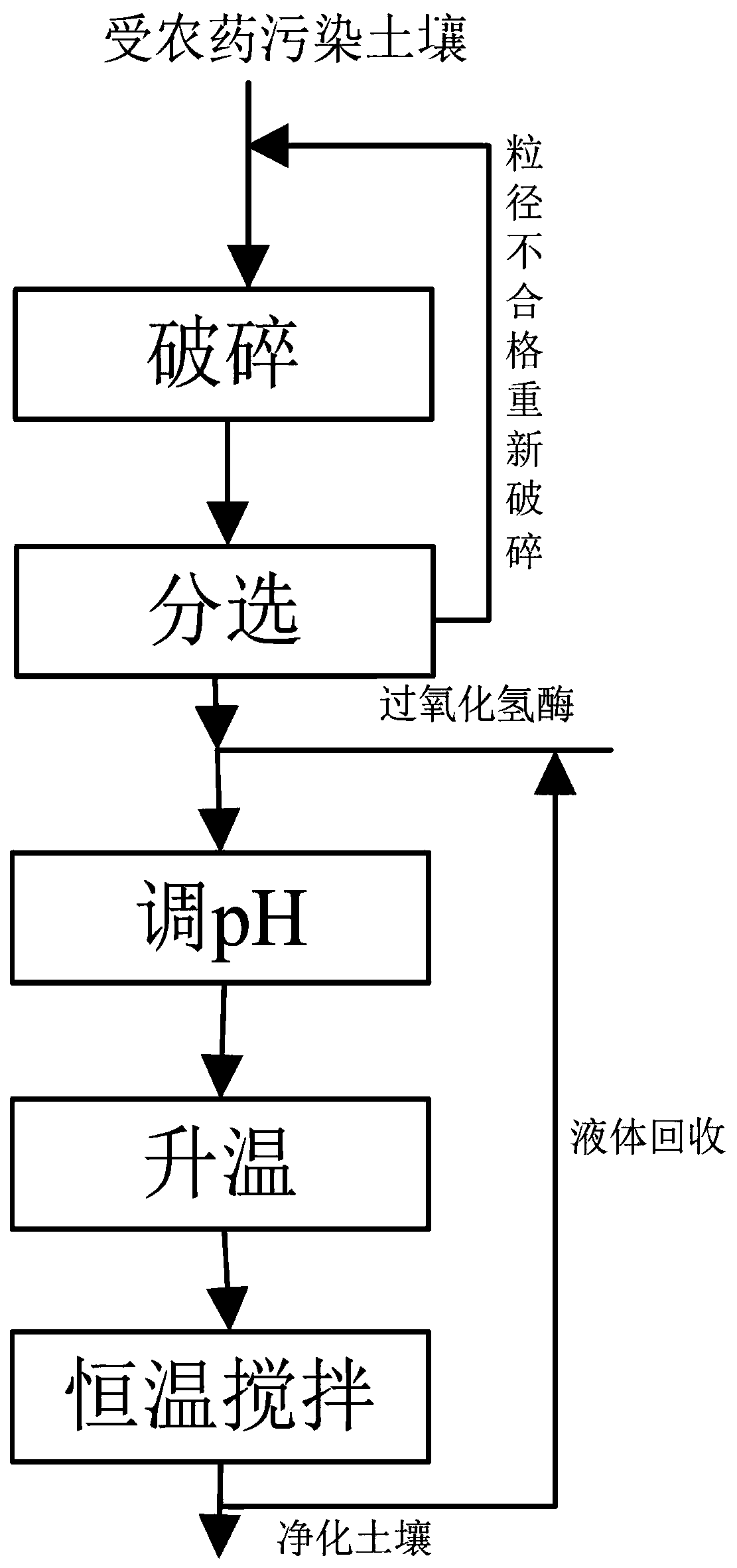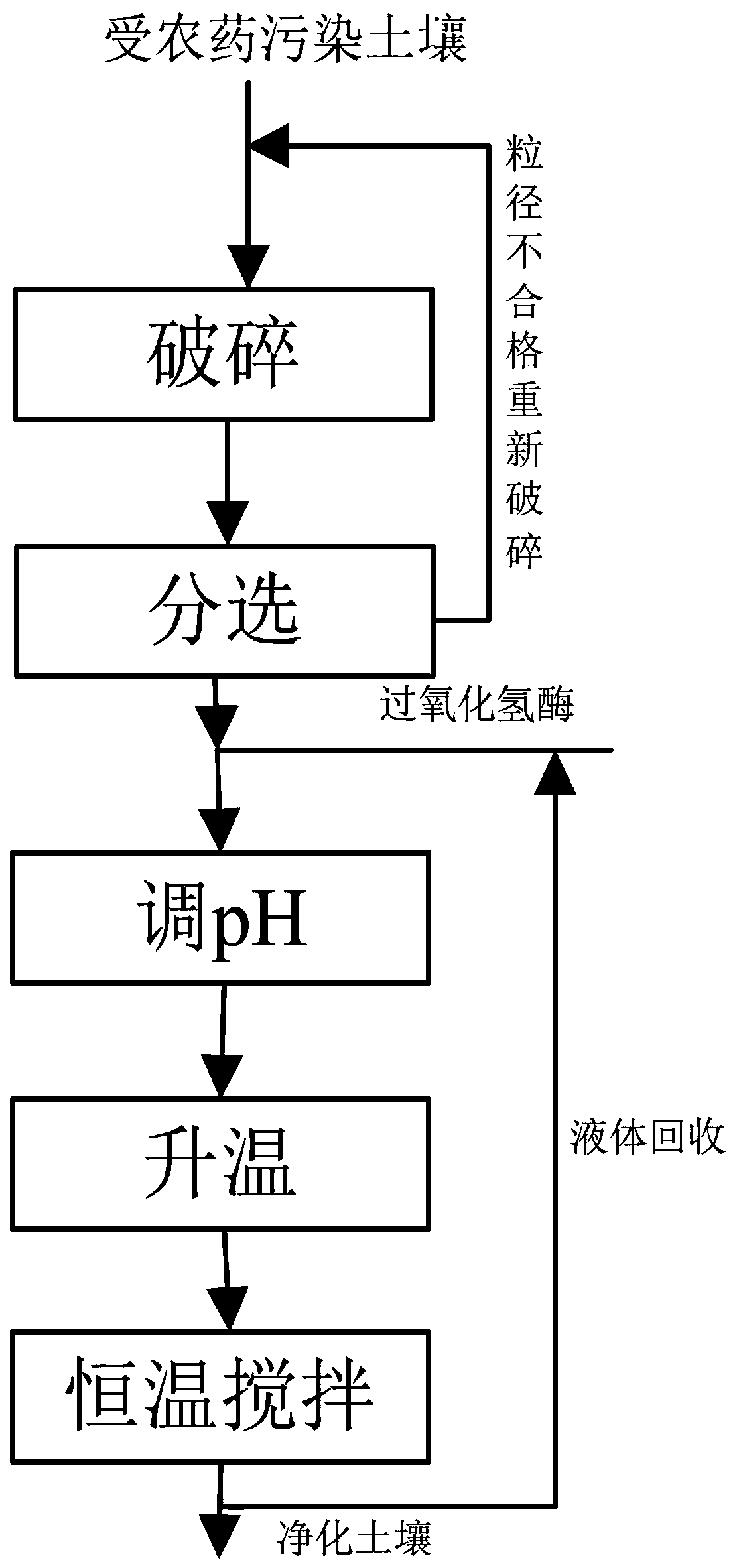Remediation method for pesticide-contaminated soil
A pesticide-contaminated soil and pesticide-contaminated technology, applied in the field of environmental engineering, can solve the problems of high harm, slow degradation, persistent pollution, etc., and achieve the effect of changing soil properties and eliminating toxicity
- Summary
- Abstract
- Description
- Claims
- Application Information
AI Technical Summary
Problems solved by technology
Method used
Image
Examples
Embodiment 1
[0022] This embodiment relates to a kind of processing method of soil contaminated by pesticides, such as figure 1 As shown, it specifically includes the following steps:
[0023] S1. After crushing the pesticide-contaminated soil, sieve it to a particle size of 100 mesh to obtain secondary soil;
[0024] S2. According to the dosage of 0.8g per gram of secondary soil, add a catalase solution with a concentration of 60mg / L in the secondary soil, after the dispersion is uniform, shake at a constant temperature for 12h, adjust the pH value to 7, Get tertiary soil;
[0025] S3. After raising the temperature of the tertiary soil to 40° C., solid-liquid separation is carried out, the liquid part is collected to carry out the operations of steps S2-S3, and the solid part is backfilled.
[0026] The Omethoate pesticide residue concentration in the soil before the treatment of heavy metal pollution in this example was 13.1mg / kg, and the residual concentration of lambda-cyhalothrin wa...
Embodiment 2
[0028] This embodiment relates to a kind of processing method of soil contaminated by pesticides, such as figure 1 As shown, it specifically includes the following steps:
[0029] S1. After crushing the pesticide-contaminated soil, sieve it to a particle size of 100 mesh to obtain secondary soil;
[0030] S2. Add catalase solution with a concentration of 40-60 mg / L to the secondary soil according to the dosage of 0.8 g per gram of secondary soil. After uniform dispersion, shake at constant temperature for 12 hours, and adjust the pH value to 7. Get tertiary soil;
[0031] S3. After raising the temperature of the tertiary soil to 40° C., solid-liquid separation is carried out, the liquid part is collected to carry out the operations of steps S2-S3, and the solid part is backfilled.
[0032] The Omethoate pesticide residue concentration 15.2mg / kg in the soil before the soil treatment of this example heavy metal pollution, the degradation rate of Omethoate after the above-menti...
Embodiment 3
[0034] This embodiment relates to a kind of processing method of soil contaminated by pesticides, such as figure 1 As shown, it specifically includes the following steps:
[0035] S1. After crushing the pesticide-contaminated soil, sieve it to a particle size of 100 mesh to obtain secondary soil;
[0036] S2. According to the dosage of 0.8g per gram of secondary soil, add a catalase solution with a concentration of 60mg / L in the secondary soil, after the dispersion is uniform, shake at a constant temperature for 12h, adjust the pH value to 7, Get tertiary soil;
[0037] S3. After raising the temperature of the tertiary soil to 40° C., solid-liquid separation is carried out, the liquid part is collected to carry out the operations of steps S2-S3, and the solid part is backfilled.
[0038] The residual concentration of lambda-cyhalothrin in the heavy metal-polluted soil in this example before the treatment was 21.2 mg / kg, and the degradation rate of lambda-cyhalothrin was 75.2...
PUM
 Login to View More
Login to View More Abstract
Description
Claims
Application Information
 Login to View More
Login to View More - R&D
- Intellectual Property
- Life Sciences
- Materials
- Tech Scout
- Unparalleled Data Quality
- Higher Quality Content
- 60% Fewer Hallucinations
Browse by: Latest US Patents, China's latest patents, Technical Efficacy Thesaurus, Application Domain, Technology Topic, Popular Technical Reports.
© 2025 PatSnap. All rights reserved.Legal|Privacy policy|Modern Slavery Act Transparency Statement|Sitemap|About US| Contact US: help@patsnap.com


